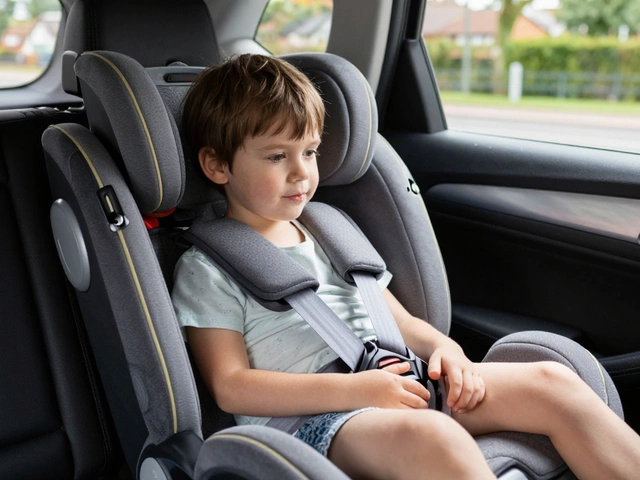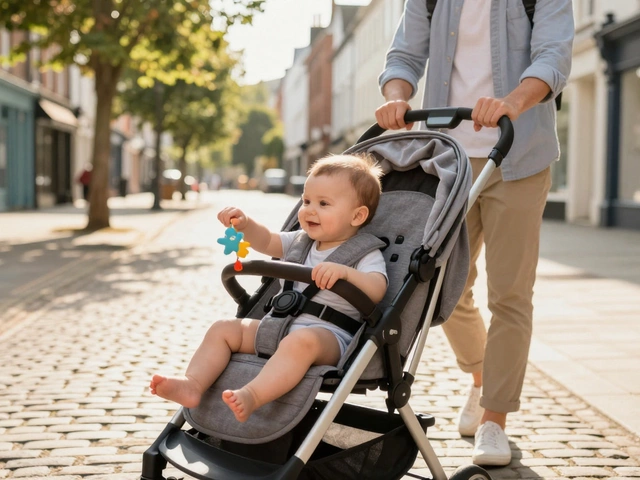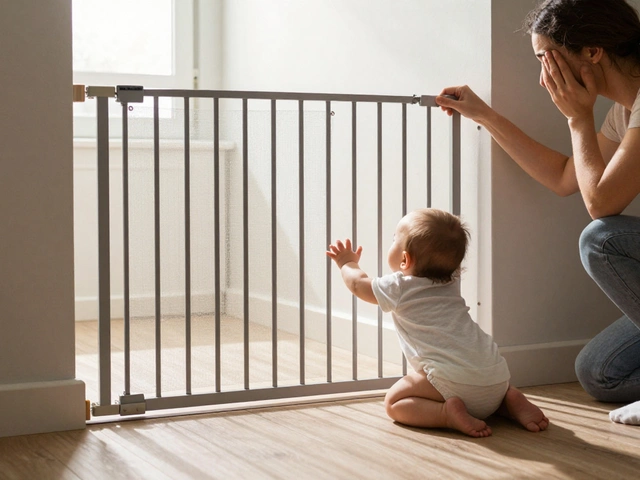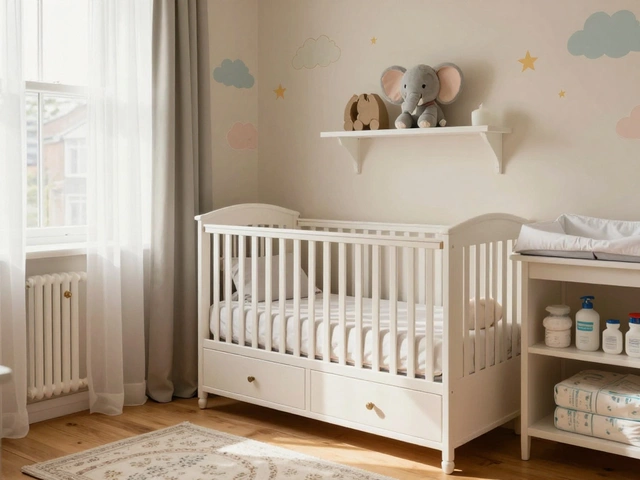
Watching your baby grow and hit new milestones is one of the most exciting parts of parenthood. At around three months old, many parents notice their babies becoming more alert and often wonder what developmental changes are happening. A common question that arises is whether it’s okay to help an infant sit up at this tender age.
This curiosity often leads to early attempts to support their baby in a sitting position, sometimes using baby carriers. But is this advisable? The decision involves understanding the baby’s physiological readiness and potential impacts on their spine and hip alignment.
Join us as we explore the nuances of infant development at three months, evaluate the role of baby carriers, and present safe practices for nurturing your baby's growth. While it’s natural to be eager about each new phase, it’s vital to stay informed to make the best choice for your child's health and happiness.
- Developmental Milestones at Three Months
- The Physiology of Sitting Up
- Baby Carriers and Posture
- Safety Tips for Parents
- Alternatives to Sitting Up
Developmental Milestones at Three Months
At just three months old, your baby is embarking on a fascinating journey of rapid growth and development. Physically, a baby at this age starts gaining more control over their neck muscles, although their head may still bob at times when unsupported. This progression is an early indicator of the physical strength and coordination your child will continue to develop. As the baby sitting at 3 months question surfaces, it’s crucial to note that neck stability is a key factor in determining readiness.
You'll observe that babies at this stage begin to focus more with their eyes, following moving objects and even reaching for them, marking a leap in their visual and motor skills. This period is also ripe for emotional and social development, as infants begin to express excitement and joy through smiles and coos. They become more responsive, reacting happily when interacting with familiar faces. Such engagement is pivotal, fostering a bond that encourages further exploration and communication.
Additionally, your baby’s brain is in overdrive, working hard to process information. The cognitive abilities expand as they experiment with their surroundings, responding to different textures, sounds, and colors. As such, enriching their environment with varied stimuli aids their mental and emotional development. Encouraging tummy time is recommended by pediatricians, as it helps strengthen both arm and neck muscles, eventually assisting with their ability to roll over and, later, sit up.
"At three months, babies are like sponges, absorbing a tremendous amount of information from their environment," mentions Dr. Amy George, a pediatric neurologist. "It's a phase where they lay the groundwork for essential milestone achievements."
Indeed, awareness of social exchanges also blossoms during this time. Babies start distinguishing familiar voices from strangers', which contributes to their sense of security. Smiles in response to voices or faces become more frequent, reflecting their burgeoning personality. Child development experts emphasize nurturing this phase with gentle interaction and engagement, as it lays the foundation for future relationships and communication skills.
The Physiology of Sitting Up
When we think about infant posture and the act of sitting up, it's worth noting how delicate and underdeveloped a baby's musculoskeletal system is at three months. At this age, the muscles in the neck, back, and core are just beginning to strengthen. The process of lifting their little heads during tummy time lays the foundation for independent sitting, usually achieved closer to six months. This is the era when babies gradually build the strength needed to hold their heads up without flopping and to maintain some balance when gently supported. Before then, their bodies are not equipped to bear the pressures that come with sitting without assistance, as their spine is still in the early stages of forming the natural curves seen in adults.
Babies' bones are more cartilaginous, allowing for more flexibility and growth, yet this flexibility also means they are more vulnerable to inappropriate postures. When you help your baby into a sitting position too early without the adequate neck and back muscle tone, it could lead to unnecessary strain. This lack of development is why pediatricians usually suggest waiting until a baby reaches certain milestones, like rolling over or gaining more head control, before introducing more upright sitting positions in any setting.
"Encouraging development through proper physical progress is crucial. Aim to let nature guide, rather than rushing into artificial milestones," says Dr. Emily Fisher, a well-regarded pediatrician at the Child Growth Institute.
Not only is muscular strength essential, but the formation of natural curves in the spine is fundamental to safe sitting postures. The C-shaped spine of a newborn begins to take on an S-shape through appropriate physical activity and growth. This transition supports load distribution and movement coordination. Sitting up too early might interfere with these natural developments, causing strains or potential long-term impacts on a child's skeletal structure, which is why cautious guidance on this topic is emphasized by child development experts.
When considering baby carriers, it’s pivotal to select models that support the natural curvature of a newborn's spine. These carriers should not only focus on comfort but also on maintaining physiological support for babies under six months. Recent studies have shown a reduction in infant postural issues when carriers designed with ergonomic considerations are used. Opting for slings and wraps that align with a baby’s natural position can prevent unwanted stress on the immature bones and connective tissues.

Baby Carriers and Posture
When considering the use of baby carriers for a three-month-old, understanding the impact on an infant's developing body is crucial. At this age, babies are still enhancing their neck and head control, which are foundational skills for sitting up independently. The professional guidelines often suggest that support is vital until babies can hold themselves up, usually happening around the four to six-month mark. Using baby carriers prematurely might make it tempting to skip this crucial development phase.
The primary role of a baby carrier is to offer a convenient and safe way for parents to transport their infants while maintaining support for a baby's spine and hips. It’s essential to choose carriers designed to ensure that a baby’s hips are in a natural position, often referred to as the "M" position, which encourages healthy hip development. According to healthcare experts, incorrect positioning could lead to issues such as hip dysplasia, especially when the carrier doesn't provide sufficient support or causes the baby's legs to dangle inappropriately.
One notable thing about modern infant posture technology is the significant variety of carriers available in the market. There is everything from slings to structured carriers that promise ergonomically-sound solutions. Each comes with certain pros and cons, and parents should be mindful of the manufacturer's instructions and the guidelines set out by pediatric experts. For babies as young as three months, carriers with adjustable positions can be beneficial. These allow gradual adjustment of the infant's seating position as they grow and develop.
An element worth considering is expert recommendations. According to the International Hip Dysplasia Institute, ensuring proper seating in a carrier encompasses more than comfort—the goal is to mimic the natural fetal tuck position with legs spread apart, legs raised, and knees bent. This not only aids in easing spinal tension but also supports stronger muscle development. Renowned pediatricians have emphasized in various forums how crucial it is to attend to such details, noting that infant spine and hips require distinct positioning to grow properly.
"Proper positioning in a carrier can support your baby's fragile developing muscles and joints, aiding in a more natural growth cycle. Ensure the spine forms a gentle curve which is critical during these formative months," explains Dr. Jane Lombard, a pediatric specialist in child development.
When choosing a baby carrier for a young infant, look for features such as adjustable seating zones and convenient headrests that keep your baby’s neck supported. Adjustable carriers aren’t just great for comfort; they also scale with the baby's growth, ensuring long-term usability. Investing in a quality carrier with a reputation for ergonomic support can make all the difference for your child’s posture during transportation. Ultimately, paying attention to how these tools impact your infant's growth is an important decision and goes a long way toward safeguarding their health.
Safety Tips for Parents
Embracing the journey of parenthood often comes with its own set of questions and safety concerns, especially as your little one begins to explore their surroundings. At three months old, your baby is experiencing a world brimming with new sights and sensations. However, as delightful as these changes are, it's vital to consider safety during this developmental stage. Let's delve into some tips specifically designed to aid parents during this milestone while ensuring their baby's security and wellness.Baby sitting at 3 months requires careful consideration, especially when it comes to posture and comfort. Ensuring that your baby is seated securely and comfortably is paramount. While experimenting with sitting up, always provide ample support to the infant’s head and neck on account of their delicate spine. A simple way to do this is by using pillows or rolled-up towels for additional support. Remember that your baby is in a crucial stage of strengthening their muscles, so take every precaution to help them achieve a balanced posture.
When it comes to using baby carriers, choosing the right one can make all the difference. Look for carriers that support your child's hips and provide adequate padding for their back, as improper support can lead to developmental issues. The International Hip Dysplasia Institute recommends that baby carriers should allow for the hips to spread naturally to keep the joints healthy. You should regularly check for product recalls or reviews to ensure that the carrier you select hasn't been flagged for safety issues. It's also necessary to frequently examine any equipment for signs of wear and tear.
"While baby carriers can certainly ease parents’ daily activities by keeping their hands free, choosing the wrong type can inadvertently strain a baby's soft tissues," advises Dr. Linda Donavan Harper, a noted pediatric specialist.
Practicing infant posture correctly is an essential part of their growth. Avoid keeping your baby in the same position for extended periods; variety in positioning aids muscle development and encourages active movement as they develop. Incorporate tummy time into daily routines to build strength in their neck, shoulders, and arms, gradual preparation for when they eventually begin sitting independently. Establishing a balanced rotation of activities not only aids physical growth but complements their neurological development as well, striking a balance with mental stimulation.
In your quest to keep your baby’s environment safe, always stay attuned to the material and fabric used in carriers and other baby products. Specifically, avoid synthetic fabrics that might irritate their sensitive skin, preferring breathable and hypoallergenic materials instead. The same diligence should be applied to ensuring that buckles, clasps, and adjustment straps are firmly secured and free of defects. Regular monitoring and attention to detail can often prevent potential mishaps, fostering a comfortable and secure experience for both you and your child.
Being well-informed is crucial, and staying updated with guidelines and expert recommendations is a key tool in your arsenal for safeguarding your baby's welfare. Whether reading up on the latest advancements in baby care or joining parenting forums to exchange experiences, the wealth of available knowledge serves as a robust foundation upon which you can build your parenting practices. Trust your instincts as much as you trust the resources available; they are often a parent’s best guide and ally when it comes to making informed decisions, ensuring that you and your baby can enjoy these early months to the fullest.

Alternatives to Sitting Up
Exploring alternatives to sitting your baby up at three months can open up a world of healthy, developmentally appropriate activities. At this tender age, your baby’s muscles, especially their neck and back, are rapidly developing, and it's essential to support this natural growth process. Instead of focusing on sitting up, consider tummy time, which is highly beneficial. Tummy time encourages your baby to lift their head, strengthening the neck, shoulder, and arm muscles. Experts recommend several short tummy time sessions throughout the day—starting from a minute or two, gradually increasing as your baby grows. Not only does it build strength, but it also plays a crucial role in preventing flat spots on the back of your baby’s head, enhancing motor skills and crawling readiness.
Interactive play is another engaging alternative that stimulates infant development. Try using colorful and safe toys designed for three-month-olds. By placing them just out of reach, you’ll encourage your child to move their arms and legs, improving coordination and cognitive engagement. Baby gyms or activity mats offer visual and tactile stimuli that can captivate your baby’s attention and promote movement. Remember, your interaction is just as important—talk to your baby, sing songs, and read stories, which supports language development and emotional bonding.
Babywearing is another suitable alternative that doesn’t require your baby to sit up on their own. In the right kind of baby carrier, your infant can benefit from the soothing comfort of your close proximity while feeling secure and supported. Many carriers are designed to keep your baby’s spine in a natural 'C' curve and their hips in a healthy position, reducing stress on the developing body. When using baby carriers, ensure that your child’s airways are clear and never in a slumped position. Baby development researchers suggest that upright carriers that offer sufficient neck support can be a wonderful way to enhance parental bonding while maintaining safety.
Consider incorporating sensory experiences suitable for your baby’s age. Allowing your baby to explore different textures, sounds, and even safe fragrances under supervision can enrich their experience of the world around them. This can include anything from the feel of a soft feather on their cheek to the sound of a gentle lullaby. Creating a balance of rest, stimulation, and bonding time will provide the best opportunities for growth. Remember, each baby is unique, so it is important to observe and adapt activities based on their interests and development stage, ensuring that your infant remains engaged and happy.
Health professionals often guide that it’s crucial to observe your baby’s unique development pace. According to Dr. Sarah Brenan, a pediatric therapist, "Every baby reaches milestones at their own speed, and it’s important to support them with patience and a variety of activities."
Her advice underscores that while it's natural to be excited about your baby advancing through developmental stages, restricting their movement can be counterproductive. Encouraging the use of limbs and head control before sitting up independently is a gentle way to foster their development.






